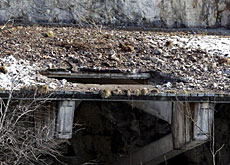
Rock falls call tunnel safety into question

The Swiss transport authorities are carrying out safety checks on the country's many open-sided tunnels and covered roads built to protect against rock falls.
The nationwide investigation follows two recent incidents when falling rocks blocked main roads, closing them to traffic for days.
Although no one was injured, the fact that the protection tunnels and open-sided tunnels – known as galleries – failed to do their job has raised safety fears.
Tunnels are an important feature of the mountainous Swiss landscape and the authorities take their obligation to ensure safety very seriously indeed.
Innovative safety measures were introduced last year in the Gotthard tunnel – Switzerland’s main north-south axis – after a fire in 2001 left 11 people dead.
The investigation into the rock falls is expected to look at whether the galleries were built to the standards laid down by the federal authorities. It is due to be undertaken by all cantons and completed by the end of April.
High risk
While conceding that two such incidents in as many months was unusual, a spokesman for the federal roads authority said rock falls had to be expected in a country like Switzerland.
“These things are happening all the time,” Daniel Schneider told swissinfo. “We live in a mountain area… where you live with the risk of rock fall.”
In the latest incident on Monday a five-cubic-metre chunk of rock came crashing down on the Axen road between Brunnen and Sisikon on the banks of Lake Lucerne.
As in the previous rock fall five weeks ago near Lake Brienz, the roof of the gallery caved in under the weight of the falling stones, blocking the road.
No cars were in the tunnel at the time.
Strong tunnels
Schneider said the gallery had been built to withstand 200 kilogrammes of falling rock. However, the wall of rock that fell on the Axen road gallery was estimated to weigh eight tons.
He said a rock fall of this magnitude would only occur once every 20 to 80 years. The risks of rock fall were carefully and individually assessed when every new protection tunnel or gallery was built.
“Every tunnel and every gallery is constructed [to withstand] a certain amount of rock fall, and we have very strict regulations on how to construct a road or railway in a dangerous area,” Schneider told swissinfo.
He said his office was awaiting the results of the investigation to see whether these regulations were strict enough: “If we have to strengthen our regulations we will do that, we will not hesitate.”
Risk elimination
But Kurt Jenk, who is responsible for road construction in canton Bern, said that in mountain areas there would always be a risk of vehicles being caught in rock falls.
“However much you monitor the situation and protect against [rock fall] you can never totally eliminate the risk,” he told swissinfo.
“People travelling in cars or trains must accept that risk. There is no absolute security,” Jenk said.
swissinfo, Urs Maurer and Morven McLean
The federal roads authority has called on all Swiss cantons to check the safety of their protection tunnels after two rock falls blocked roads for days.
In the latest incident a block of rock weighing eight tons collapsed on a road running alongside Lake Lucerne.
The authority says all tunnels are built in accordance with strict safety regulations, but the risk to motorists can never be completely eliminated.

In compliance with the JTI standards
More: SWI swissinfo.ch certified by the Journalism Trust Initiative















![The four-metre-long painting "Sonntag der Bergbauern" [Sunday of the Mountain Farmers, 1923-24/26] had to be removed by a crane from the German Chancellery in Berlin for the exhibition in Bern.](https://www.swissinfo.ch/content/wp-content/uploads/sites/13/2025/12/01_Pressebild_KirchnerxKirchner.jpg?ver=a45b19f3)













You can find an overview of ongoing debates with our journalists here . Please join us!
If you want to start a conversation about a topic raised in this article or want to report factual errors, email us at english@swissinfo.ch.